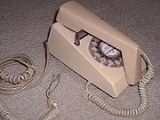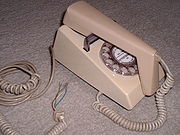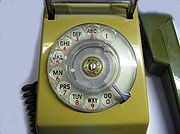
Trimphone
Encyclopedia



Telephone
The telephone , colloquially referred to as a phone, is a telecommunications device that transmits and receives sounds, usually the human voice. Telephones are a point-to-point communication system whose most basic function is to allow two people separated by large distances to talk to each other...
designed in the 1960s in the UK
United Kingdom
The United Kingdom of Great Britain and Northern IrelandIn the United Kingdom and Dependencies, other languages have been officially recognised as legitimate autochthonous languages under the European Charter for Regional or Minority Languages...
. It was positioned as a more fashionable alternative to the standard telephones available from the GPO, the predecessor to British Telecom
BT Group
BT Group plc is a global telecommunications services company headquartered in London, United Kingdom. It is one of the largest telecommunications services companies in the world and has operations in more than 170 countries. Through its BT Global Services division it is a major supplier of...
. The name is an acronym standing for Tone Ring Illuminator Model, referring to the then innovative electronic ringer ("warbling", as opposed to the traditional bell) and the illuminated dial. The luminous dial or betalight contained the mildly radioactive element tritium
Tritium
Tritium is a radioactive isotope of hydrogen. The nucleus of tritium contains one proton and two neutrons, whereas the nucleus of protium contains one proton and no neutrons...
, which caused some concern about safety.
Although a later model featured buttons that did not light up instead of the original dial, it continued to be known as the Trimphone. Consumers were divided as to its aesthetic merits, and some models required rewiring in order to connect to the public phone network in the UK.
This innovative design by Standard Telephones and Cables
Standard Telephones and Cables
Standard Telephones and Cables Ltd was a British telephone, telegraph, radio, telecommunications and related equipment R&D manufacturer. During its history STC invented and developed several groundbreaking new technologies including PCM and optical fibres.The company began life in London as...
(STC), half the weight of the more traditional 700-type telephone, originated in 1961 when the Post Office decided it needed a luxury telephone to add to its range. Towards the end of 1963 the Post Office settled on the design by STC, and in 1964 placed a contract for 10,000 units.
The Trimphone started life in 1964 as the Telephone No. 712 and was designed by Martyn Rowlands. The Telephone No.712 featured an alphabetical as well as numerical dial whereas the Telephone No. 722 did not. The Trimphone was the first in the GPO range to use a tone caller which warbled at around 2000 Hz modulated by ringing current. The volume of the ringer gradually built up over the first few cycles. There is a volume control in the base of the telephone with 'loud', 'medium' and 'soft' settings (a silent setting was achieved by slackening off a screw on the tone ringer board inside the phone).
Production of the new telephone commenced in 1965 by STC, and an initial quantity of 1000 was offered to customers on a selective trial basis in the London North West Telephone Area in the same year. It became available throughout the country in 1966, at extra rental cost, with a choice of three two-tone colour schemes: grey-white, grey-green and two-tone blue. The first example of the Trimphone was presented in May 1965 by the Postmaster General, Tony Benn
Tony Benn
Anthony Neil Wedgwood "Tony" Benn, PC is a British Labour Party politician and a former MP and Cabinet Minister.His successful campaign to renounce his hereditary peerage was instrumental in the creation of the Peerage Act 1963...
, to a newly wed couple in Hampstead in a ceremony marking the ten millionth telephone to be installed in Britain. By 1980 there were 1.6 million Trimphones in use out of a total telephone population at that time of 27 million.
There was also some concern about the luminescent dial that glowed green in the dark. This effect came from a small glass tube of tritium gas, which gave off beta radiation and made the dial fluoresce. Although the radioactivity was equivalent only to that given off by a wristwatch it was felt wise to withdraw this facility as public concern over radioactivity grew.
Another problem with the dial version of the Trimphone was its light weight, 0.8 kg compared with 1.4 kg for the 700-type and 2.6 kg for the 300-type telephone. This led to the complaint that on slippery surfaces the telephone turned and slid whilst dialling. The fix for this was to wet the feet and the phone stuck to the table.
An improved version, the Telephone No. 722, was introduced in 1970.
The first keypad version of the Trimphone appeared in 1977 - somewhat delayed by the problem of packaging the signalling electronics into the small volume of the Trimphone. The problem was alleviated by marginally increasing the height of the case compared to the dial version. The first design of keypad Trimphone to achieve large-scale production was the SC version (Tele 766); this design incorporates relays, but does not require batteries. Subsequent designs eased the packaging problems further by eliminating the relays and introducing transistor pulsing. An MF4 (Touch-tone) design had to await the development of an integrated circuit to replace the bulky coils and capacitors otherwise needed. This was introduced in 1979 (Tele 786).
The Trimphone was featured prominently in the 1970s British TV series UFO (TV series)
UFO (TV series)
UFO is a 1970-1971 British television science fiction series about an alien invasion of Earth, created by Gerry Anderson and Sylvia Anderson with Reg Hill, and produced by the Andersons and Lew Grade's Century 21 Productions for Grade's ITC Entertainment company.UFO first aired in the UK and Canada...
.
The next incarnation of the Trimphone was the Deltaphone.
The Deltaphone was a deluxe version of the trimphone where the case was bound in leather.
By 1980 Trimphones had been around for some 15 years and needed revamping for the new era of competition.
The final incarnation (or rather reincarnation) of the Trimphone was a collection of alternative colour range Trimphones called the 'Snowdon Collection'
See also
- EricofonEricofonThe Ericofon, or Cobra Phone is a plastic one-piece telephone created by the Ericsson Company and marketed throughout the second half of the 20th century. It was the first commercially marketed telephone design to incorporate the dial and handset into a single unit...
- a SwedishSwedenSweden , officially the Kingdom of Sweden , is a Nordic country on the Scandinavian Peninsula in Northern Europe. Sweden borders with Norway and Finland and is connected to Denmark by a bridge-tunnel across the Öresund....
phone that was similarly fashionable in its day. - GrilloGrillo telephoneThe Grillo telephone was designed in 1965 by Marco Zanuso and Richard Sapper. The telephone was manufactured in Italy by Società Italiana Telecomunicazioni Siemens...
- Another innovative telephone, from ItalyItalyItaly , officially the Italian Republic languages]] under the European Charter for Regional or Minority Languages. In each of these, Italy's official name is as follows:;;;;;;;;), is a unitary parliamentary republic in South-Central Europe. To the north it borders France, Switzerland, Austria and...
. Its design anticipated the cellular "flip-phone". - TrimlineTrimline telephoneThe Western Electric Trimline telephone is a variety of telephone set designed by Donald Genaro of Henry Dreyfuss Associates for the Bell System . It was built by the Bell System's manufacturing arm, Western Electric. The idea behind the Trimline telephone was to create an alternative telephone...
- The Trimline phone, from USA, incorporated a dial into the handset, but still had a separate cradle containing the ringer. - GPO TelephonesGPO telephonesThe United Kingdom's General Post Office had a number of telephones that were provided by them for connection to their exchanges. Until 1982 the GPO had a monopoly on the provision of all telephones within the UK and so the range was limited...
- GPO Telephones
External links
- UK Telephones 1960-80
- UK Telephones Post 1980
- Telephone File
- http://www.retrowow.co.uk/retro_technology/telephone/telephone.html

